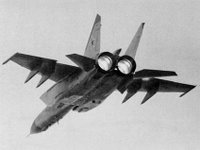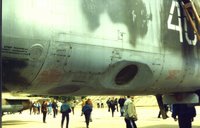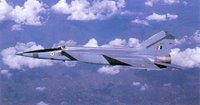 On May1, 2006, the Indian Air Force bid farewell to one of its most coveted and hush-hush assets – the Mikoyan-Gurevich MiG-25RB “Foxbat”, known in the Air Force as “Garuda”. With the departure of the Foxbat, the Indian Air Force will not only lose its fastest aircraft, but also its premier spyplane – an aircraft that served it very well for over twenty-five years.
On May1, 2006, the Indian Air Force bid farewell to one of its most coveted and hush-hush assets – the Mikoyan-Gurevich MiG-25RB “Foxbat”, known in the Air Force as “Garuda”. With the departure of the Foxbat, the Indian Air Force will not only lose its fastest aircraft, but also its premier spyplane – an aircraft that served it very well for over twenty-five years. Indeed, it would be very difficult to find an Air Force officer who disagrees with Wing Commander Sanjeev Taliyan, who once commanded the MiG-25 squadron, when he says, “No aircraft has ever been able to achieve for us what the Foxbat has. We will miss flying them.”
Shiv Aroor of the Indian Express has written an excellent article on the topic. In the 1950s, the United States began development of the North American XB-70 “Valkyrie” high-altitude bomber with a top speed of Mach 3. The Valkyrie never saw service, but the fighter that was intended to intercept it did. The Mikoyan-Gurevich MiG-25 “Foxbat” first flew in 1964, and entered service with the Voenno-Vozdushniye Sily (Soviet Air Force) in 1969. With a top speed of Mach 3, a ceiling of more than 90,000ft, and an astonishing climb rate (According to think tank globalsecurity.org, a MiG-25 can take off and climb to an altitude of 114,000ft in a little over four minutes), the VVS had an interceptor the West simply couldn’t match. To put these figures into perspective, let me state that some of the best fighter aircraft of its era, like the F-4 Phantom II, the MiG-23 "Flogger" and even later aircraft like the F-16 Fighting Falcon, the Mirage-2000, and the MiG-29 "Fulcrum" struggle to reach Mach 2.5 and cannot fly above 60,000 feet. It remained an enigmatic and much-feared aircraft in the West, until a Soviet pilot, Lt. Viktor Balenko defected with one to Japan in 1976. The detailed examination it was subjected to dispelled much of the aura of invincibility surrounding the Foxbat. It was found that in spite of the speed and altitude at which it flew, the MiG-25 was mostly constructed out of steel, with titanium and aircraft aluminium being used only in some heat-critical areas. Welding was done by hand, and rivet heads were exposed in places they did not affect aerodynamic drag. Most of the on-board electronics, including the radar, consisted of vacuum tubes. The radar itself was not as sophisticated as Western radars and lacked the “look-down shoot-down” capability essential for tracking and shooting down low-flying targets. Though a speed of Mach 3.2 was achievable, the engines would burn up and require replacement if pushed beyond Mach 2.8.
In the 1950s, the United States began development of the North American XB-70 “Valkyrie” high-altitude bomber with a top speed of Mach 3. The Valkyrie never saw service, but the fighter that was intended to intercept it did. The Mikoyan-Gurevich MiG-25 “Foxbat” first flew in 1964, and entered service with the Voenno-Vozdushniye Sily (Soviet Air Force) in 1969. With a top speed of Mach 3, a ceiling of more than 90,000ft, and an astonishing climb rate (According to think tank globalsecurity.org, a MiG-25 can take off and climb to an altitude of 114,000ft in a little over four minutes), the VVS had an interceptor the West simply couldn’t match. To put these figures into perspective, let me state that some of the best fighter aircraft of its era, like the F-4 Phantom II, the MiG-23 "Flogger" and even later aircraft like the F-16 Fighting Falcon, the Mirage-2000, and the MiG-29 "Fulcrum" struggle to reach Mach 2.5 and cannot fly above 60,000 feet. It remained an enigmatic and much-feared aircraft in the West, until a Soviet pilot, Lt. Viktor Balenko defected with one to Japan in 1976. The detailed examination it was subjected to dispelled much of the aura of invincibility surrounding the Foxbat. It was found that in spite of the speed and altitude at which it flew, the MiG-25 was mostly constructed out of steel, with titanium and aircraft aluminium being used only in some heat-critical areas. Welding was done by hand, and rivet heads were exposed in places they did not affect aerodynamic drag. Most of the on-board electronics, including the radar, consisted of vacuum tubes. The radar itself was not as sophisticated as Western radars and lacked the “look-down shoot-down” capability essential for tracking and shooting down low-flying targets. Though a speed of Mach 3.2 was achievable, the engines would burn up and require replacement if pushed beyond Mach 2.8.
 However, the MiG-25 also had some clear virtues from the outset. It was quintessentially a Soviet aircraft, being relatively inexpensive, rugged, reliable, easy to maintain, and straightforward to operate. It was representative of MiG’s philosophy of building world-class fighter aircraft using decade-old technology. The RP-25 “Smerch” 500kW radar could burn through heavy jamming, and had a detection range of 100 kilometres. In fact, pilots were not allowed to engage it on the ground, and it is said that this radar was powerful enough to kill rabbits near the runway. Also, many engineers claim that the much-ridiculed vacuum tube electronics are perfectly practical and cost-effective for high-power microwave applications, and are less susceptible to radiation in case of a nuclear attack.
However, the MiG-25 also had some clear virtues from the outset. It was quintessentially a Soviet aircraft, being relatively inexpensive, rugged, reliable, easy to maintain, and straightforward to operate. It was representative of MiG’s philosophy of building world-class fighter aircraft using decade-old technology. The RP-25 “Smerch” 500kW radar could burn through heavy jamming, and had a detection range of 100 kilometres. In fact, pilots were not allowed to engage it on the ground, and it is said that this radar was powerful enough to kill rabbits near the runway. Also, many engineers claim that the much-ridiculed vacuum tube electronics are perfectly practical and cost-effective for high-power microwave applications, and are less susceptible to radiation in case of a nuclear attack.
 India acquired twelve MiG-25 aircraft from the USSR in 1980 for “strategic reconnaissance” over Pakistan, China, and some other very interesting countries. At that time, India did not have the capability to penetrate deep into Pakistani and Chinese airspace and take pictures of their military installations. Of these twelve Foxbats, ten were reconnaissance/bomber versions, (MiG-25RB), while two were conversion trainers with two separate cockpits (MiG-25U). These aircraft formed the No. 102 “Trisonics” squadron, based at Bareilly. However, more recently, only four of these have remained in service, with No. 35 “Rapiers” squadron. According to the Indian Air Force website, “the aircraft is equipped with a number of electromagnetic-spectrum sensors along with a larger and more capable Side-Looking Airborne Radar (SLAR) than the older MiG-25”. It also comes with “two left-to-right rotating cameras with a focal length of 650mm and/or 1300mm, which can be fitted in the three interchangeable camera bays located in the nose cone of the aircraft. The two cameras shoot through two port and two starboard windows, and a vertical camera with a shorter focal length is located under the cockpit to take horizon-to-horizon shots.” While interceptor versions of the MiG-25 carried four air-to-air missiles, the MiG-25R has no defensive armament of its own, nor is it equipped with advanced countermeasures against air-to-air or surface-to-air missiles. Instead, it relies on its high cruising altitude and blinding speed to escape enemy air-defences. Indeed, there are few things in the world that can bring down a Foxbat doing Mach 2.8 at an altitude of 90,000 feet.
India acquired twelve MiG-25 aircraft from the USSR in 1980 for “strategic reconnaissance” over Pakistan, China, and some other very interesting countries. At that time, India did not have the capability to penetrate deep into Pakistani and Chinese airspace and take pictures of their military installations. Of these twelve Foxbats, ten were reconnaissance/bomber versions, (MiG-25RB), while two were conversion trainers with two separate cockpits (MiG-25U). These aircraft formed the No. 102 “Trisonics” squadron, based at Bareilly. However, more recently, only four of these have remained in service, with No. 35 “Rapiers” squadron. According to the Indian Air Force website, “the aircraft is equipped with a number of electromagnetic-spectrum sensors along with a larger and more capable Side-Looking Airborne Radar (SLAR) than the older MiG-25”. It also comes with “two left-to-right rotating cameras with a focal length of 650mm and/or 1300mm, which can be fitted in the three interchangeable camera bays located in the nose cone of the aircraft. The two cameras shoot through two port and two starboard windows, and a vertical camera with a shorter focal length is located under the cockpit to take horizon-to-horizon shots.” While interceptor versions of the MiG-25 carried four air-to-air missiles, the MiG-25R has no defensive armament of its own, nor is it equipped with advanced countermeasures against air-to-air or surface-to-air missiles. Instead, it relies on its high cruising altitude and blinding speed to escape enemy air-defences. Indeed, there are few things in the world that can bring down a Foxbat doing Mach 2.8 at an altitude of 90,000 feet.
 After entering service, the Foxbats have been said to routinely intrude into hostile airspace to spy on enemy facilities. They were used in Operation Pawan (Sri Lanka), Operation Brass Tacks (Rajasthan desert – 1987), and Operation Safed Sagar (Kargil – 1999). During Brass Tacks, the Air Chief Marshal, Dennis La Fontaine, proposed that the Foxbat be used to spy on Pakistani armoured movements – an idea shot down by Rajeev Gandhi. During the Kargil War, MiG-25s were extensively used for aerial reconnaissance after a relatively low-flying Canberra suffered damage after being hit by a hand-held surface-to-air missile while photographing Pakistani positions. And while most of the Foxbat’s exploits remain shrouded in secrecy, one incident did manage to make headlines. In 1997, an Indian Air Force MiG-25 broke the sound barrier over Islamabad while returning from a reconnaissance mission, causing a huge sonic boom. Resembling a series of explosions, the sound caused the residents of Islamabad to panic, and alerted Pakistani air defences into action. A few F-16s were scrambled from Sargodha, but they could do little to intercept an aeroplane flying well above 65,000 feet at a speed greater than Mach 2. The Pakistani foreign minister stated that the Pakistani Air Force did not have anything in their inventory to intercept aircraft flying at that height. Some in the PAF also said that their F-16s had an operational ceiling of 55,000 feet, which was insufficient to intercept the Foxbat. Many in the Pakistani establishment considered the breaking of the sound barrier to be deliberate – to prove that the PAF did not have the capability to intercept the Foxbat.
After entering service, the Foxbats have been said to routinely intrude into hostile airspace to spy on enemy facilities. They were used in Operation Pawan (Sri Lanka), Operation Brass Tacks (Rajasthan desert – 1987), and Operation Safed Sagar (Kargil – 1999). During Brass Tacks, the Air Chief Marshal, Dennis La Fontaine, proposed that the Foxbat be used to spy on Pakistani armoured movements – an idea shot down by Rajeev Gandhi. During the Kargil War, MiG-25s were extensively used for aerial reconnaissance after a relatively low-flying Canberra suffered damage after being hit by a hand-held surface-to-air missile while photographing Pakistani positions. And while most of the Foxbat’s exploits remain shrouded in secrecy, one incident did manage to make headlines. In 1997, an Indian Air Force MiG-25 broke the sound barrier over Islamabad while returning from a reconnaissance mission, causing a huge sonic boom. Resembling a series of explosions, the sound caused the residents of Islamabad to panic, and alerted Pakistani air defences into action. A few F-16s were scrambled from Sargodha, but they could do little to intercept an aeroplane flying well above 65,000 feet at a speed greater than Mach 2. The Pakistani foreign minister stated that the Pakistani Air Force did not have anything in their inventory to intercept aircraft flying at that height. Some in the PAF also said that their F-16s had an operational ceiling of 55,000 feet, which was insufficient to intercept the Foxbat. Many in the Pakistani establishment considered the breaking of the sound barrier to be deliberate – to prove that the PAF did not have the capability to intercept the Foxbat.
 However, there is a limit to which an airframe can be flogged, and as Wing Commander Ashok Chauhan of the Rapiers Squadron puts it, “we can push our Foxbats for another 2-3 years, but after three life extensions, it’s prudent to retire them now”. There is little doubt that the retirement of the MiG-25RB has left a gaping hole in India’s capability to spy on Pakistan and China with impunity. There are many who claim that Indian intelligence needs are being catered to by spy satellites like the Technology Experiment Satellite (with one metre resolution), which is why the acquisition of high-altitude spy planes is not on the top of the list of priorities for the Defence Ministry. However, spy satellites have certain limitations – limitations which can be overcome only by spy planes like the MiG-25RB or the SR-71 “Blackbird”. Spy satellites follow a predictable path which permits limited deviation, and there is only a small window of time to gather data. This makes them easy to "fool", something India managed to do to US satellites while preparing for its nuclear tests in Pokhran. The US, clearly the top dog when it comes to such satellites, was found groping in the dark when India finally detonated the devices. Moreover, the utility of satellite photographs is affected by the time of the day – photographs taken at noon are preferred to those taken late in the evening, when long shadows might hide important details. Spy planes, on the other hand, can overfly enemy territory whenever and wherever required, making it difficult for the ene
However, there is a limit to which an airframe can be flogged, and as Wing Commander Ashok Chauhan of the Rapiers Squadron puts it, “we can push our Foxbats for another 2-3 years, but after three life extensions, it’s prudent to retire them now”. There is little doubt that the retirement of the MiG-25RB has left a gaping hole in India’s capability to spy on Pakistan and China with impunity. There are many who claim that Indian intelligence needs are being catered to by spy satellites like the Technology Experiment Satellite (with one metre resolution), which is why the acquisition of high-altitude spy planes is not on the top of the list of priorities for the Defence Ministry. However, spy satellites have certain limitations – limitations which can be overcome only by spy planes like the MiG-25RB or the SR-71 “Blackbird”. Spy satellites follow a predictable path which permits limited deviation, and there is only a small window of time to gather data. This makes them easy to "fool", something India managed to do to US satellites while preparing for its nuclear tests in Pokhran. The US, clearly the top dog when it comes to such satellites, was found groping in the dark when India finally detonated the devices. Moreover, the utility of satellite photographs is affected by the time of the day – photographs taken at noon are preferred to those taken late in the evening, when long shadows might hide important details. Spy planes, on the other hand, can overfly enemy territory whenever and wherever required, making it difficult for the ene my to hide stuff from them. Also, spy planes can collect air samples from the test sites of nuclear and other weapons - something satellites may never be able to do. There are reports that Russia had offered the MiG-31 “Foxhound” (shown right), a heavily modernised MiG-25 to India in a buy back offer. With better engines, an insanely powerful look-down shoot-down radar, better reliability, and vastly improved low altitude performance, the MiG-31 seems to be just what the doctor ordered for the Air Force. Fitted with state-of-the-art surveillance equipment and sensors, the yet non-existent reconnaissance version of the MiG-31 is sure to meet India’s strategic reconnaissance needs for at least the next twenty years. While purchase and maintenance costs will be very high, the information obtained would surely justify the expenses. Moreover, with India’s economy going great guns, acquisition of these birds won’t put a major strain on our resources, the Multi Role Combat Aircraft, Scorpene, and Gorshkov deals notwithstanding.
my to hide stuff from them. Also, spy planes can collect air samples from the test sites of nuclear and other weapons - something satellites may never be able to do. There are reports that Russia had offered the MiG-31 “Foxhound” (shown right), a heavily modernised MiG-25 to India in a buy back offer. With better engines, an insanely powerful look-down shoot-down radar, better reliability, and vastly improved low altitude performance, the MiG-31 seems to be just what the doctor ordered for the Air Force. Fitted with state-of-the-art surveillance equipment and sensors, the yet non-existent reconnaissance version of the MiG-31 is sure to meet India’s strategic reconnaissance needs for at least the next twenty years. While purchase and maintenance costs will be very high, the information obtained would surely justify the expenses. Moreover, with India’s economy going great guns, acquisition of these birds won’t put a major strain on our resources, the Multi Role Combat Aircraft, Scorpene, and Gorshkov deals notwithstanding.




















